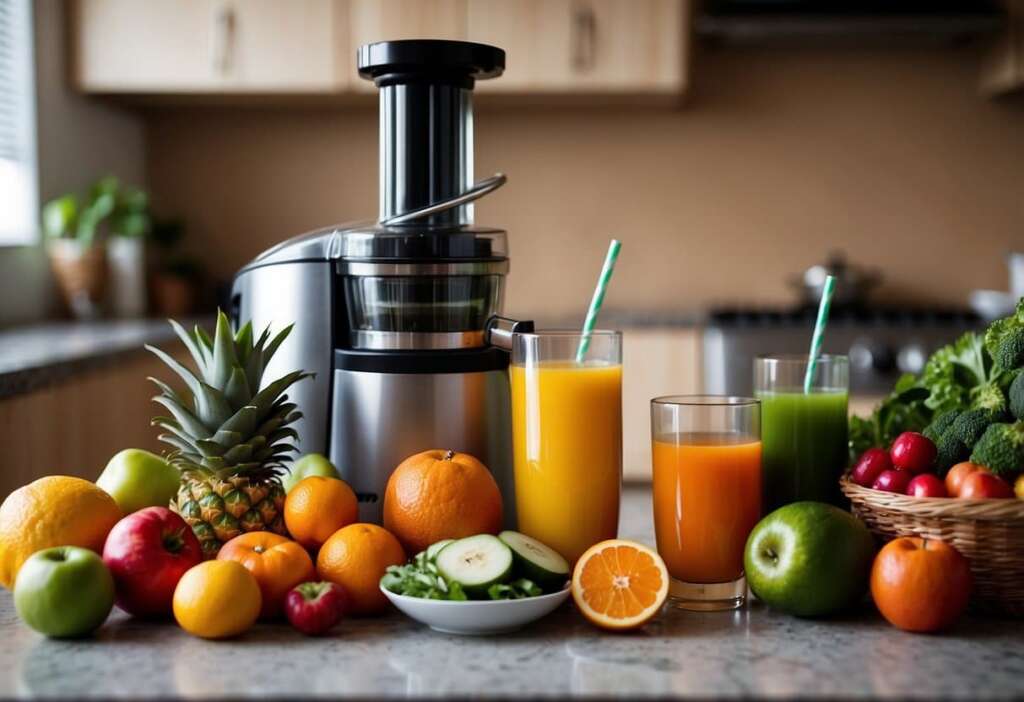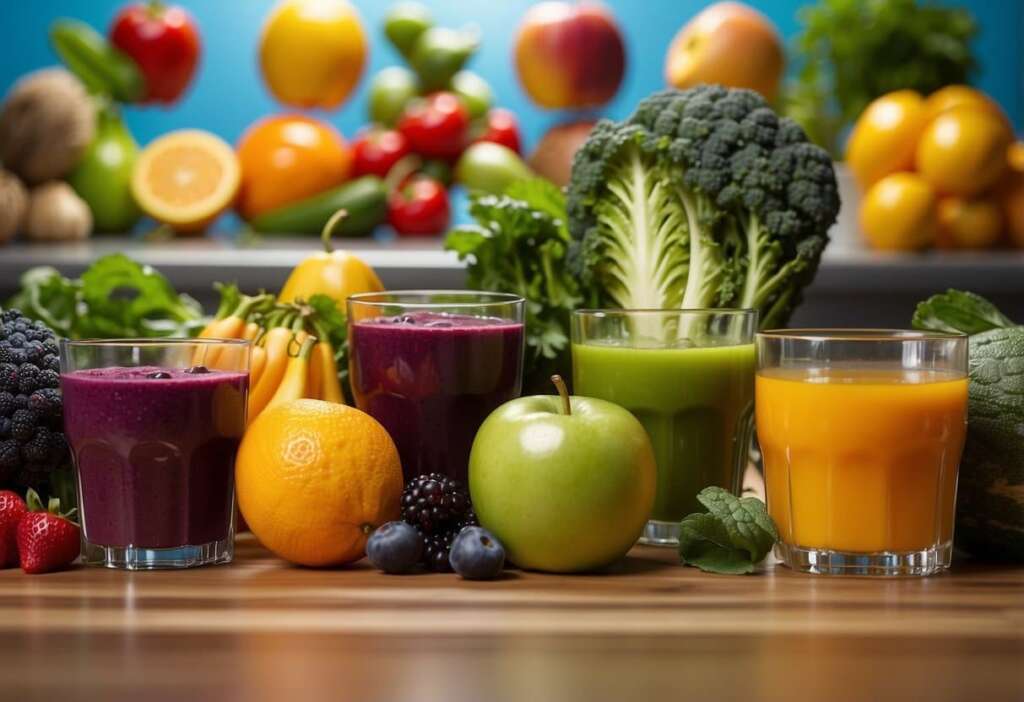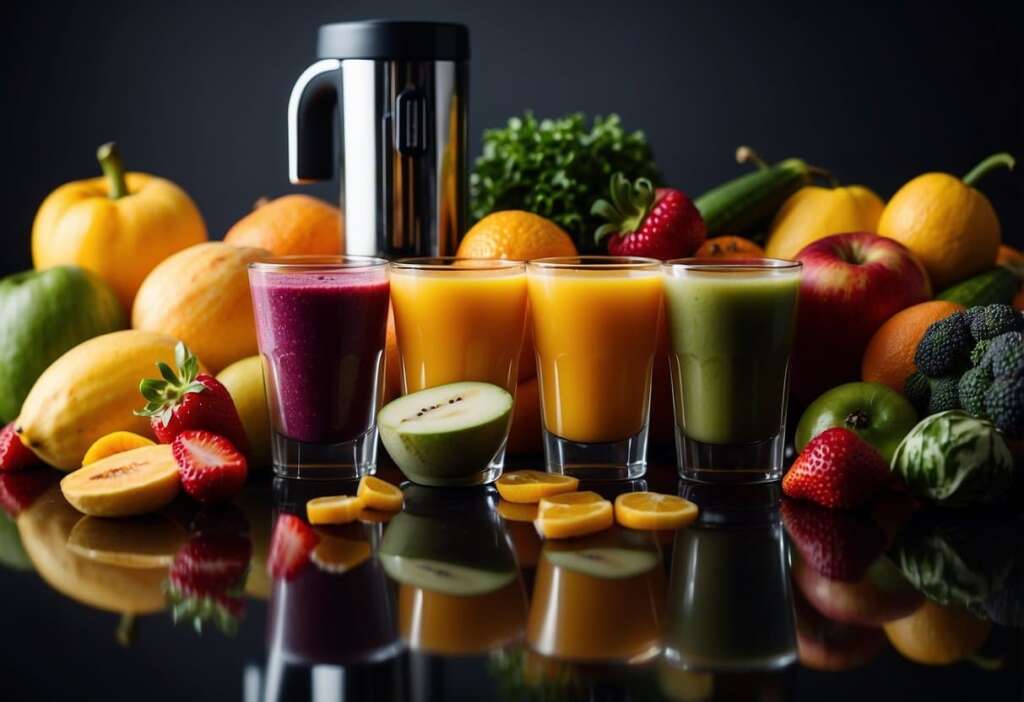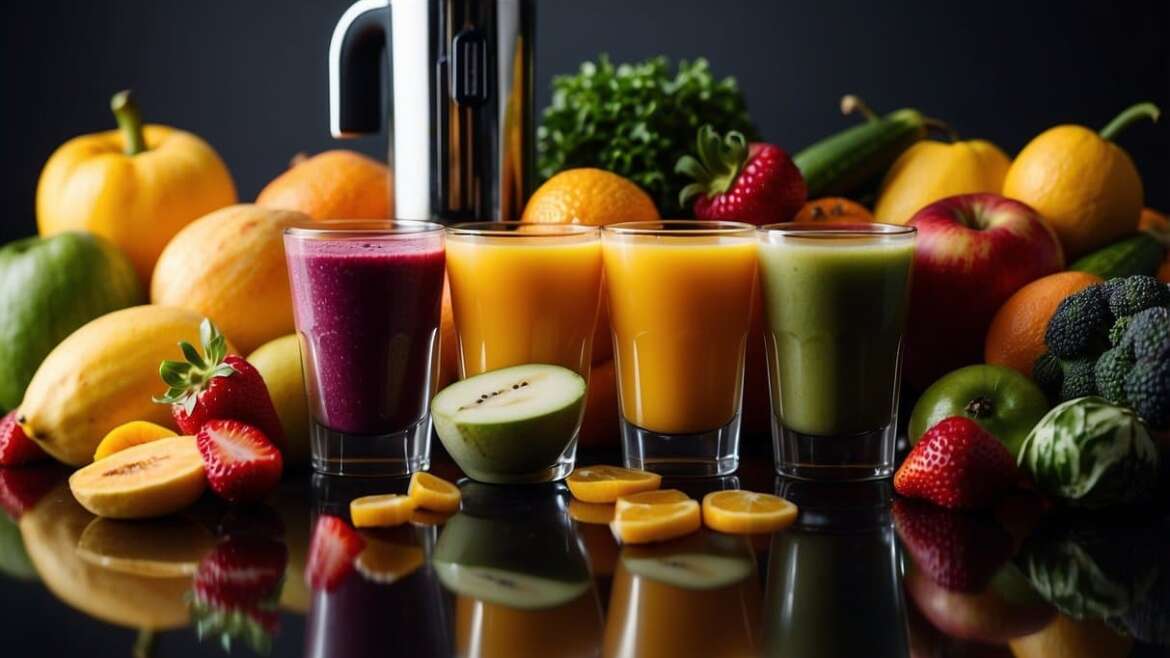Juicing is a popular way to enjoy fruits and vegetables while getting a boost of nutrients. People love it because it’s a simple method to include more vitamins and minerals in their diet. Juicing allows individuals to consume a concentrated source of nutrients with ease. There are easily more than 10 benefits of juicing. Here’s why…

Fresh juices made from produce like carrots, spinach, and oranges help improve overall health. They contain essential vitamins and minerals that the body needs to function properly. By incorporating these juices into daily routines, many find their energy levels improve.
Besides being healthy, juicing can be quite enjoyable. The wide variety of fruits and vegetables available means endless combinations of flavours. Experimenting with different ingredients keeps things interesting and ensures a balanced intake of various nutrients.
Understanding Juicing and Its Components
Juicing involves extracting liquid from fruits and vegetables, providing a convenient way to consume essential nutrients. Different types of juicers are available, each with its unique benefits. The juice retains key vitamins and minerals that are beneficial to health.
What Is Juicing?
Juicing is the process of extracting juice from fresh fruits and vegetables. This separates the liquid from the pulp, leaving a nutrient-rich drink. People juice to increase their intake of fruits and vegetables easily.
Juicing can help those who struggle to eat enough whole fruits and vegetables. Drinking fresh juice can be a quick way to get a variety of nutrients. It can also be more enjoyable for some than eating the raw ingredients.
Types of Juicers
Choosing the right juicer is important. There are two main types: centrifugal juicers and cold-press juicers.
Centrifugal juicers use a fast-spinning blade to separate the juice from the pulp. They are fast and usually cheaper, but the high speed can generate heat, which might reduce some nutrient quality.
Cold-press juicers: Also called masticating juicers, they crush and press fruits and vegetables slowly. This method preserves more nutrients. They are typically more expensive and slower, but they produce juice with a higher nutrient content and longer shelf life.
Key Nutrients in Juice
Juicing retains many vital vitamins, minerals, and other nutrients from fruits and vegetables. Common nutrients found in juice include:
- Vitamin C: Found in citrus fruits like oranges and lemons. Supports the immune system.
- Vitamin A: Present in carrots and leafy greens. Important for eye health.
- Potassium: Found in bananas and spinach. Helps with heart function and muscle health.
- Folate: Present in many green vegetables. It is important for cell growth and metabolism.
- Antioxidants: Help fight oxidative stress and inflammation. Found in berries and many other fruits.
Including a wide variety of fruits and vegetables in juicing can ensure a broad spectrum of nutrients. This can help achieve balanced nutrient intake efficiently.
Health Advantages of Juicing
Juicing can improve nutrient intake, digestion, and the immune system. It can also aid in detoxification, weight loss, and boost energy levels.
Enhanced Nutrient Intake
Juicing provides a quick way to get a large amount of vitamins and minerals. Fresh juice often contains more nutrients compared to eating whole fruits and vegetables. The body absorbs these nutrients faster. Ingredients like spinach, kale, and carrots are rich in vitamins A, C, and K, as well as antioxidants. This makes it easier to meet daily nutrient requirements.
Improved Digestion
Juicing removes most of the fibre, which can make it easier for the digestive system to process the nutrients. This can be beneficial for people with compromised digestion. Some fruits and vegetables, like ginger and pineapple, contain enzymes that help break down food. They can soothe the digestive tract and reduce bloating and inflammation.
Boosted Immune System
Juices from fruits and vegetables like oranges, carrots, and spinach are high in vitamins C and A. These vitamins are essential for a healthy immune system. Antioxidants found in many fruits and vegetables help protect the body from oxidative stress. This can make the immune system more robust and better able to fight off infections.
Detoxification and Weight Loss
Juicing can help the body detoxify by providing a high intake of antioxidants and nutrients. It can also aid weight loss by reducing cravings for unhealthy snacks. Juices made from vegetables like cucumber and celery are low in calories but high in water content, promoting hydration and fullness. This makes it easier to stick to a healthy diet.
Increased Energy Levels
Juicing can boost energy levels by providing a quick source of natural sugars and nutrients. Fresh juices help to stabilize blood sugar levels. Ingredients like beets and oranges are particularly effective for providing a natural energy boost. These nutrients are easily absorbed, giving the body an immediate source of energy without the crash associated with processed sugars.
Comparing Juicing and Whole Fruits
Juicing and eating whole fruits differ mainly in fibre content and the impact on blood sugar levels.
Fiber Content and Absorption
Whole fruits contain a lot of fibre, which helps in digestion.
Fibre is important because it slows down the absorption of sugar into the bloodstream. When fruits are juiced, much of this fibre is lost. This can result in quicker sugar absorption, which might not be ideal for those watching their blood sugar levels.
Eating whole fruits means getting both soluble and insoluble fibres. Soluble fibre helps control blood sugar, while insoluble fibre aids in digestion. Juicing removes these fibres, changing how the body processes the fruit’s sugars. Thus, whole fruits are better for fibre intake and steady absorption rates.
Sugar Intake and Blood Sugar Levels
Juicing can lead to higher sugar intake compared to eating whole fruits.
When fruits are juiced, the natural sugars become more concentrated. Drinking fruit juice often results in taking in more sugar than eating whole fruits. This can cause a rapid spike in blood sugar levels. Whole fruits, with their fibre, lead to a slower and more controlled release of sugar into the blood.
People with blood sugar level concerns might prefer whole fruits over juice. The fibre in whole fruits helps to moderate the increase in blood sugar. In contrast, juiced fruits lack the fibre that helps keep sugar absorption in check.
Eating whole fruits rather than drinking juice can be a better choice for managing sugar intake and maintaining stable blood sugar levels.
Juicing for Specific Health Outcomes
Juicing can offer various benefits for specific health conditions like heart disease, aging skin, cancer, diabetes, and obesity. Here’s how juicing can help in these areas.
Heart Health and Blood Pressure
Juicing can be beneficial for heart health and blood pressure management. Ingredients like beets, pomegranates, and greens are rich in nitrates, which help open up blood vessels.
Beet juice is known for its ability to lower blood pressure. It contains nitrates that convert to nitric oxide, promoting healthy blood flow. Pomegranates are also helpful because they have high antioxidant levels that protect the heart.
Adding leafy greens like spinach and kale to juice can offer a good dose of potassium and magnesium. These minerals are crucial for controlling blood pressure and supporting the heart.
Anti-Aging and Skin Benefits
Juicing can play a role in anti-aging and improving skin health. Many fruits and vegetables are packed with antioxidants and vitamins that protect against aging.
Carrot juice is a popular choice for healthy skin. It contains beta-carotene, which helps keep skin smooth and glowing. Lemon juice has vitamin C, which is vital for collagen production, helping to maintain skin elasticity.
Cucumbers in juice provide hydration and silica, both of which are crucial for keeping skin moisturized and firm. Regular intake of these juices can help slow down the signs of aging.
Cancer Prevention and Immunity
Including certain ingredients in your juice can aid in cancer prevention and boost immunity. Antioxidants in many fruits and vegetables protect cells from damage that can lead to cancer.
Green juices often contain spinach and kale, which have high levels of antioxidants. These antioxidants support the immune system and help reduce cancer risk. Citrus fruits like oranges and lemons are rich in vitamin C, another powerful antioxidant.
Adding berries to your juice can also enhance your immune response. Berries like blueberries and strawberries contain flavonoids that help fight off free radicals, supporting overall health.
Management of Diabetes and Obesity
Juicing can be tailored to help manage diabetes and obesity by choosing the right ingredients with low glycemic indexes and high nutrient content.
Green apple juice is a good choice for managing blood sugar levels. It has a lower glycemic index than other fruits, making it safer for diabetics. Leafy greens like kale and spinach ensure the juice is nutrient-dense but low in sugars.
Cucumber and celery juices provide volume and hydration without adding many calories. They help you feel fuller longer, making it easier to control weight. Including a balance of vegetables and low-sugar fruits can aid in managing both diabetes and obesity.
Optimizing Your Juicing Experience

To make the most out of juicing, it’s important to choose the best ingredients, balance flavours and nutrients, avoid common mistakes, and properly maintain your juicer.
Choosing the Right Ingredients
Selecting the freshest and highest quality ingredients is key. Look for organic options to reduce pesticide exposure. Fresh fruits like apples, oranges, and strawberries can add sweetness. Vegetables such as carrots, beets, and celery provide nutrition. Incorporating leafy greens like spinach and kale ensures essential vitamins and minerals.
Ensuring a mix of fruits and vegetables enhances both the nutritional value and taste. It’s also useful to wash all produce thoroughly to remove any pesticides and dirt. Variety in your ingredients helps keep your juice interesting and offers a broader range of nutrients.
Balancing Flavors and Nutrients
A balanced juice combines various flavours and nutrients. Too many fruits can make the juice overly sweet, while too many vegetables might make it taste too earthy.
A good rule of thumb is a 3:2 ratio of vegetables to fruits. This ensures the juice is tasty yet not too sugary. Leafy greens such as spinach and kale can be balanced with tangy fruits like apples or citrus to improve taste. Adding a small piece of ginger or a squeeze of lemon can also enhance the flavour.
Avoiding Common Juicing Mistakes
Common mistakes can easily ruin your juicing experience. Avoid using poor-quality or spoiled ingredients as they can affect the juice’s taste and nutritional value. Overloading the juicer with too much produce at once can damage the machine and reduce juice yield.
It’s also important to not skip washing the produce. Unwashed fruits and vegetables might contain dirt or pesticides. Balance is another key; you should aim for a variety of ingredients rather than sticking to the same ones all the time. This ensures a range of nutrients and flavors in your juice.
Cleaning and Maintaining Your Juicer
Proper upkeep of your juicer is essential for both hygiene and longevity. Clean your juicer immediately after use to prevent residue from hardening. Follow the manufacturer’s instructions for disassembling and washing the parts.
Use a small brush to remove the pulp from hard-to-reach areas. Regularly check for signs of wear and tear to keep your juicer in top condition. Proper maintenance not only keeps the juicer running smoothly but also ensures that your juice is free from unwanted contaminants.
Lifestyle Considerations and Juicing
Incorporating juicing into daily life includes balancing it with whole foods, considering nutritional needs, and evaluating environmental and economic aspects.
Incorporating Juicing into a Balanced Diet
Juicing can be part of a balanced diet but shouldn’t replace whole meals. Whole foods provide fibre, protein, and fat that juices may lack. Balance is key.
Juices are rich in vitamins and minerals, but whole fruits and vegetables offer extra fibre important for digestion. Including whole grains, proteins, and healthy fats keeps the diet diverse and balanced.
A balanced diet includes various nutrients such as carbohydrates, protein, and fats. Juicing can provide vitamins and minerals, while whole foods supply other essential nutrients.
Juicing as a Supplement to Whole Foods
Juicing should supplement, not replace, whole foods. Whole foods deliver fibre and essential nutrients missed in juices.
Combining juices with meals ensures the intake of fibre, protein, and fats. A glass of juice can complement a meal with lean proteins, grains, and vegetables.
This enhances the diet without losing balance. Avoid using juices as meal replacements; instead, let them add to your daily nutrient intake.
Environmental and Economic Factors
Choosing to juice involves considering environmental and economic impacts. Fresh produce might be costly, and some juicers consume significant electricity.
Locally sourced, seasonal produce can be more sustainable. It supports local farmers and reduces carbon footprint.
Investing in an efficient juicer can save costs long-term. Consider initial expense versus ongoing benefits, including health and energy savings. Be mindful of waste—try composting pulp for a zero-waste approach.
Navigating the Downside of Juicing

While juicing has its benefits, there are also some drawbacks. These include issues related to sugar and calorie content, potential losses of nutrients, and hygiene concerns.
Concerns Over Excessive Sugar and Calories
Fresh fruit juices can have high sugar and calorie content. Even though the sugars are natural, consuming too much can lead to weight gain and increased blood sugar levels. For instance, an 8-ounce glass of orange juice contains about 21 grams of sugar and 112 calories.
Frequent consumption can add up quickly, making it easy to consume more sugar and calories than intended. Individuals need to balance their juice intake with other foods to maintain a healthy diet. People with diabetes or watching their blood sugar levels should be particularly cautious.
Potential Nutrient Losses
Juicing can lead to the loss of important nutrients, such as fibre, vitamins, and minerals. The process of extracting juice often leaves behind the pulp, which contains most of the fibre. Fibre is crucial for digestive health and can help manage blood sugar levels.
Vitamin and mineral losses can also occur. Some vitamins, like Vitamin C, are sensitive to light and air. Exposure during juicing can decrease their potency. It’s best to consume freshly made juice quickly to minimize nutrient loss.
Hygiene and Food Safety Issues
Juicing at home can pose hygiene and food safety risks if not done properly. Fresh produce can carry bacteria that may cause foodborne illnesses. It’s critical to wash all fruits and vegetables thoroughly before juicing.
Additionally, equipment used in juicing needs to be cleaned well to avoid contamination. Leftover pulp and juice, if not cleaned promptly, can harbour bacteria. This makes regular cleaning of juicers and blenders essential to prevent health problems.
Frequently Asked Questions

Juicing can offer a variety of benefits, including health improvements and noticeable body changes. This section provides answers to common questions about daily juicing habits.
What are the health advantages of drinking fresh juice daily?
Drinking fresh juice daily can boost your intake of essential vitamins and minerals. It helps support the immune system and can improve skin health. Fresh juice is also a convenient way to increase fruit and vegetable consumption.
How can juicing vegetables improve your well-being?
Juicing vegetables can provide a concentrated source of nutrients. It helps in better digestion and supports detoxification processes in the body. Vegetables like spinach and kale are packed with antioxidants and fibre.
What noticeable effects does juicing have on the body?
Many people report increased energy levels and better digestion after starting a juicing routine. Skin health can improve with a clearer complexion and better hydration. Some also notice weight loss and reduced cravings for unhealthy foods.
How long does it typically take to experience the positive effects of a regular juicing routine?
Positive effects can be noticed within a few days to a couple of weeks. Improved digestion and energy levels are often the first changes. For more significant results, like better skin health or weight management, it may take a month or more of consistent juicing.
What are the potential drawbacks of including juicing in your diet?
Juicing can sometimes remove fibre that is essential for digestion. Consuming too much fruit juice can lead to high sugar intake. It can also be costly and time-consuming to prepare fresh juice daily.
Which ingredients are recommended for a daily juicing regimen to maximize benefits?
Good ingredients include spinach, kale, carrots, apples, and ginger. Leafy greens are high in vitamins and minerals. Carrots add sweetness and are rich in beta-carotene. Apples and ginger help improve taste and add extra nutrients.

